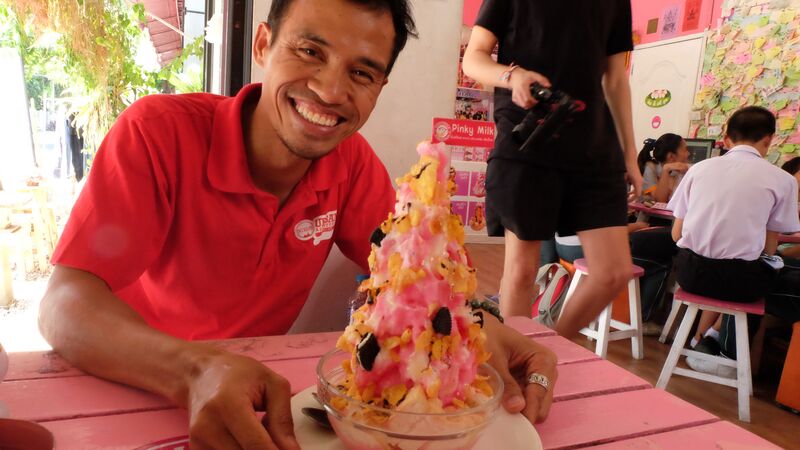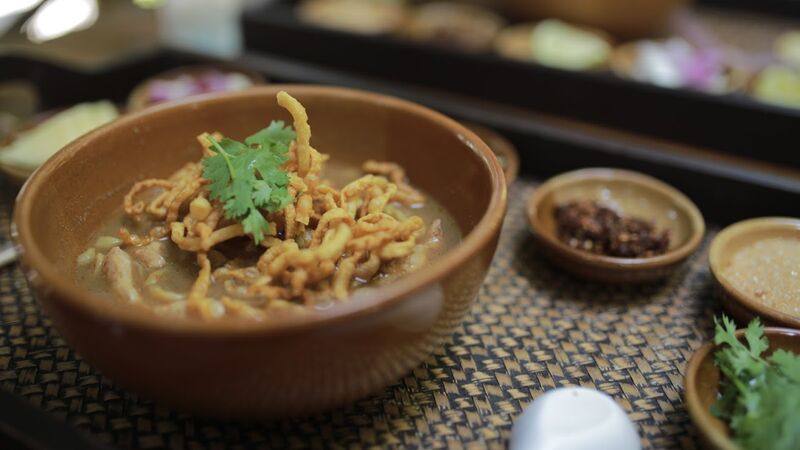
Our Thailand team go out regularly to try street food from all over the country, then they report back to us what their must-try dishes are and where to find them. From chicken curry puffs to ice cream mountains, this is the definitive list of the best street food in Chiang Mai, chosen by the locals that eat there everyday…
When Ms Somdee’s puff pastry shop opened nearly 30 years ago, there wasn’t much happening on Arak Soi 5. There were few buildings and no businesses, just her little stall (at the time, owned by her sister-in-law) selling karipap — puffed pastries filled with your choice of curried chicken, taro, or bean. But even with all the businesses and traffic and people that now buzz around the Arak Road along the old town’s western moat, Curry Puff (also known as Puff Pie) has remained hidden like a secret surprise! Karipap isn’t a treat you typically find in northern Thailand. It has southern roots, originating in the Mauk Lek district of Saraburi Province, northeast of Bangkok. This also happens to be where Ms Somdee and her family are from — and when they moved north, they brought these delicious little pastry pockets with them. A lot of places fry them the day before and then sell them,” explains Natthachai (better known as Buddy) our Urban Adventures guide. That’s clearly not the case at Curry Puff, where the karipap are deep-fried before your eyes and served to you so hot and fresh you can barely hold them, let alone bite into one. Ms Somdee’s chicken curry puffs are sweeter than you might expect, with chunks of potato mixed in with the chicken. With the potato, it’s similar to massaman curry, a mild southern curry with heavy Indian influence, but the flavour is sweeter and much lighter. The taro and bean are simultaneously sweet and savoury (as is so much of Thai food), tasting more like they’re filled with a rich cream rather than root vegetables and lentils. The shell has that perfect level of flakiness, so that when you bite into them, you get that crumbly mess that only comes from a well-made pastry.
How to find it: On Arak Soi 5, at the corner of Arak Road (west moat, inner road), just north of Suan Dok Gate in Chiang Mai Old Town.

Perhaps Sirichai Khao Man Gai’s biggest claim to fame is that no one knows its name. The shop specialising in khao man gai (Hainanese chicken rice) and khao soi (curried noodle soup) could have rocketed to tourism stardom a few years ago when a travel writer for Lonely Planet came in and decided to include it in their guide to Chiang Mai. Except the writer called it Sirisoi, not Sirichai, and since then confused tourists have been stumbling around this area behind the Three Kings Monument, trying to find a restaurant name that doesn’t exist. Saiyai, the owner for some 20 years opens her shop every morning at 5am, capturing the locals looking for their morning dose of chicken and rice before they head off to work. Khao man gai started as a southern breakfast but has since spread across all of Thailand as the ultimate start-your-day dish (#localsknow hint: you can usually identify a khao man gai shop by the poached chickens hanging in the front window). It’s nothing more than boiled chicken served over a plate of oily rice (the rice is cooked in the chicken fat and juices), and served with a side bowl of chicken broth (called nam sup), a few slices of cucumber, and occasionally a few blobs of chicken blood jelly. But while the dish may seem bland and basic, each shop offers its own subtleties, from the broth to the soya-chili sauce provided for dipping or pouring over top. Saiyai’s sauce is on the sweet side, but she has cups of chili peppers and ginger on the table for you to adjust to your tastes. There are only two dishes that Saiyai serves at her stall: the aforementioned khao man gai, and khao soi, the coconut-based noodle soup that defines northern Thai cuisine. As for which one she does better, well she’s pretty famous among locals for doing both very, very well. And since khao man gai is typically a breakfast meal and khao soi is usually eaten at lunch, we suggest just sticking around all morning so you can eat both meals here and judge for yourself.
Where to find it: Behind the Three King’s Monument, at the corner of Intrawarorot Road and Jhaban Road, in Chiang Mai Old Town.
Okay, consider this one a bit of a cheat in our off-the-grid Thailand street food list. This khao soi stall is on every “Best food in Chiang Mai” list on the internet. But it can be notoriously tricky to find if you walk past too fast; located between the temples Wat Rajamontean and Wat Khuan Khama, it’s tucked down a driveway that looks like it leads into one of the temple grounds. Khao soi is the most classic dish of Chiang Mai — you simply can’t come to town and not eat it. Its origins are Burmese with lots of Indian influence, but it has evolved over the years into a distinctly Thai flavour. Creamy coconut milk is mixed with yellow and red curry spices and served over egg noodles. Chicken is the typical protein, although you can also get pork or beef in some shops. But what makes it as pretty as it is tasty is the deep-fried crispy egg noodles served on top, along with some sprigs of cilantro and a side dish of pickled greens, onion, and lime, for you to season to your own tastes. Located on the north end of Chiang Mai’s old town, Khao Soi Khun Yai is a staple in the city — the kind of place that’s popular with farang (foreigners) and locals. It’s been in this same spot for some 15 years, catering strictly to the breakfast and lunchtime crowd (don’t be surprised if they’re sold out as early as 1pm). The khao soi is what most people come for, but Khun Yai also makes a mean kanom jeen nam ngiaw — something we’re pretty sure you’ve probably never heard of (and if you have, bravo — you’re a true Thai cuisine connoisseur). It’s typically served at khao soi stalls, although you’re unlikely to see many farang ordering a bowl, even at a place as popular as Khun Yai. This noodle soup dish has a pork-based broth, served with cherry tomatoes, bean sprouts, garlic, coriander, and a few jiggly pieces of chicken blood jelly. It’s lighter than you would expect and a bit tart in taste, and we’d wager it’s unlike any other flavour you’ve encountered in Thailand. So if you want to really go local with your eating habits, pick this dish over the more farang-friendly khao soi. Or just come back again tomorrow and try both. Grandma would approve.
Where to find it: On Soi Sri Poom 8, just off Sri Poom Road (north moat, inner road) between Wat Rajamontean and Wat Khuan Khama, in Chiang Mai Old Town. It’s down a driveway that looks like it’s leading into the temple grounds.
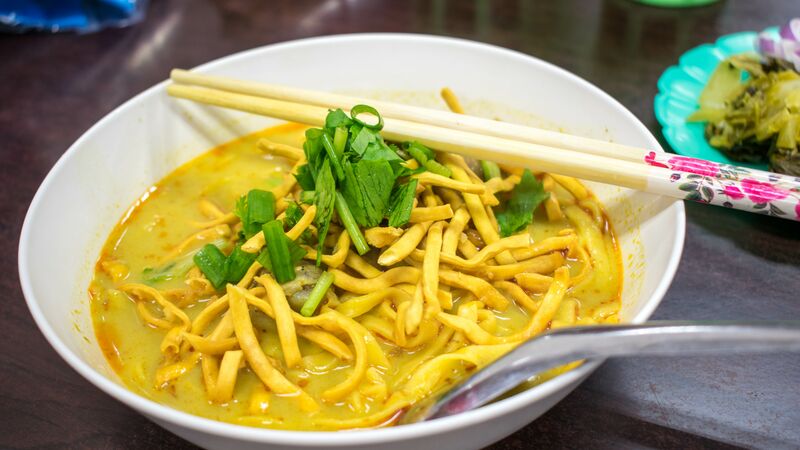
If you come to Som Tam Udon on a weekend, be prepared to wait a while. The massive restaurant is so insanely popular among locals that there’s regularly a line-up down the street. Yet despite its popularity, few travellers find their way here. It could be because of its location that’s a good way’s away from the touristy old town and the expat-filled Nimmanhaemin. Or it could be because of its intense level of spice that will challenge even the most heat-loving foodie. Order their standard som tam (papaya salad) and be prepared for your face to tingle, your lips to go numb, and your tongue to burn as though you’ve licked the sun. Or, if you’re a total masochist, get the Lao-style som tam, which is even hotter. Som tam is considered part of Isan cuisine, which explains its extreme heat factor. Isan is the region of northeastern Thailand, along the borders of Laos and Cambodia, with food that mirrors the flavours found in the neighbouring countries. As a northern city, Chiang Mai serves up a lot of Isan-inspired dishes — far more than you’ll ever find in the south. And even dishes that have worked their way south — such as som tam — have a distinct flavour in Chiang Mai, where the Isan influence holds stronger. At Som Tam Udon, there’s more than just basic papaya salad on the menu — in fact, there are nearly 30 variations of the dish on offer, some based on other fruits and vegetables, such as mango, pomelo (a citrus fruit similar to grapefruit), corn, cucumber, and santol (a seed fruit similar to lychee). And a classic som tam meal includes more than just the salad — chicken wings and nam tok moo (pork salad) are two common side dishes.
Fun fact: the word ‘nam tok moo’ translates to ‘waterfall pork’ — so named because of the way the pork juices, or water, drip from the pork while it’s cooking. Shame some of that ‘water’ can’t cool the burn on my tongue.
How to find it: On Soi Tantawan, northeast of where Highway 11 starts at Maya Shopping Centre, in Chang Phueak / Ban Sathaphon.
Rotee Mataba, on Tha Pae Road near the Chiang Mai Night Bazaar, is run by Dae (or ‘Auntie Day’ as locals call her), an Afghan-Thai woman who has been frying up rotee in the exact same spot for more than 35 years and has earned a solid reputation among locals as having the best in town. (The stall, located next to Wat Buppharam, is also known as Rotee Padae.) Her daughter now works with her, and the two have a methodical rhythm going on — one rolls out and flips and smacks the dough into a perfectly thin pancake, the other fills and fries it. The traditional rotee fillings of banana, cheese, egg, and/or chocolate are what you’ll find most people ordering — but if you’re looking for something less common, Dae also makes a killer mataba rotee. Mataba is a mild, Indian-style yellow curry, typically made with potatoes and chicken. Dae’s mataba is easy eating. It’s not spicy, so you won’t have to worry about burning heartburn if you eat one right before bed, but it’s hearty enough to satiate if you need a late-night dinner. Even if you want to stick with the more common fillings like banana and chocolate or egg and cheese, any rotee aficionado should head to Padae’s to see just how good a rotee can be when it comes with 35 years of experience.
How to find it: On Tha Pae Road at Kampangdin Road, next to Wat Buppharam and just east of the Chiang Mai Night Bazaar area.
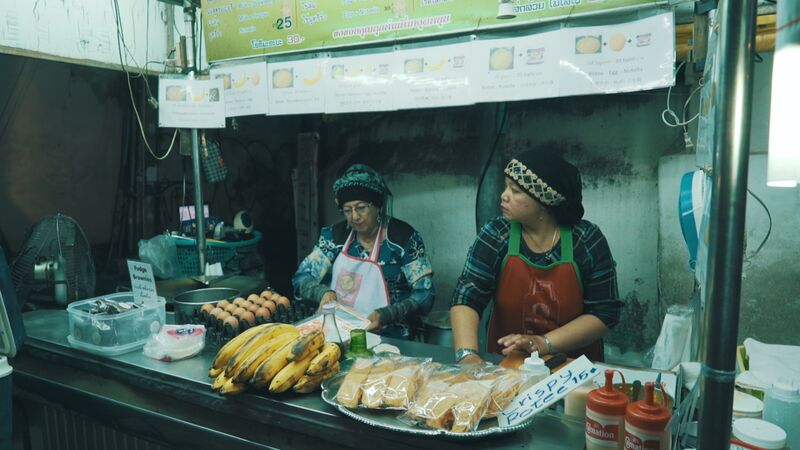
At 4am, Nek opens the doors to his family-run breakfast shop, Joke Suan Dok Gate. By 6am, the place is packed with locals, who are all ordering up one of three dishes: joke (Thai-style congee), khao tom moo (rice and pork soup), or the most popular dish, tom luad moo, or pig blood soup. By about 11am, he’s usually sold out and closed up for the day. The menu isn’t extensive, but the thing they do serve are the same things that locals line up for day after day (and night after night — he’s popular with the post-bar crowd as well). His joke is a rich, hearty breakfast of congee (rice porridge) mixed with pork and a poached egg, and topped with ginger, coriander, and green onion. It’s also utterly delicious. His rice soup is lighter in flavour but still filling as a massive bowl of pork and rice in a clear broth and garnished with garlic, coriander, and spring onion. But it’s his tom luad moo, or pig blood soup, that you should order if you want to truly eat like a local. The soy sauce-based broth is loaded with a bit of a greens and a lot of offal: pig kidney, liver, intestine, and blood jelly. It’s an acquired taste for sure, but more so for the chewy texture of the organs than their flavour, which is actually surprisingly quite mild. Nek serves it with white rice and a tangy, slightly sour chilli sauce on the side. To many, a bowl of pig parts may not sound the most appetising after a night of drinking, but it’s probably far healthier than the late-night fast food run most Western travellers are used to. And that’s the very appeal of Nek’s shop. Located near Suan Dok Gate on the west side of Chiang Mai’s old city, it could easily turn into tourist central if he wanted to cater to that crowd. But Nek keeps doing what he’s been doing for 20 years: feeding traditional Thai breakfasts to hungry locals… and to the few daring travellers who aren’t afraid of a little pig blood.
How to find it: On Arak Road (west moat, inner road), south of Arak Soi 5, just north of Suan Dok Gate in Chiang Mai Old Town.
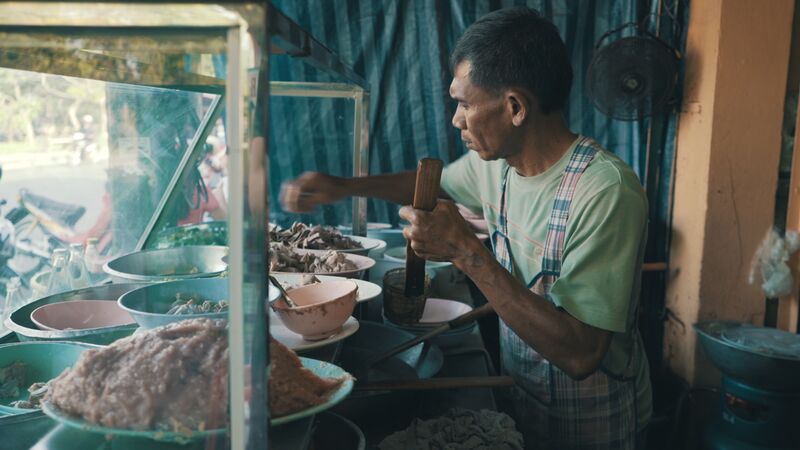
The North Gate Cowgirl is easily the most famous vendor in Chiang Mai serving up khao kha moo (stewed pork leg). That’ll happen when none other than the patron saint of food-travel, Anthony Bourdain, takes his TV crew to your stall. But she’s not the only one in town cooking delicious, fall-off-the-bone pork — and, if we want to really get bold and controversial, she might not even be the best (yes, we’re preparing for the hate mail). For another delicious, and far less crowded take on the dish, head to the south side of the old town, to Khao Kha Moo Prai Sa Nee, which literally translates to “rice leg pork post office” — because the stall is directly in front of a post office, of course. Owner Tu opened this stall some 12 years ago, after tackling many odd jobs before finding his calling as a food vendor. He’s been a barber and has worked in clothing retail, but it’s slow-cooking pork that has proven to be his true passion. His stall only comes out around 5pm, parked in front of the Phra Sing post office, and stays open until 11pm or so, when he packs the whole thing up and treks it back home until the next evening. His stewed pork is seasoned with soy sauce, hoisin sauce, sugar, and spices, and can be ordered with or without bones and skin, and is served atop rice with pickles and a boiled egg. Cloves of raw garlic and whole chili peppers are in bowls on the table — the tradition is to take a tiny bit of the garlic and a pepper in between bites of the stew (be warned: the smallest of nibbles is all you need). He also offers a pork-based wonton soup that’s mild but filling. It’s a much quieter spot than the Cowgirl’s stall over in the market along the North Gate moat. Her pork is good and her spot is hopping, but this is where to go if you want no flash and no crowds of tourists — just some good stewed pork from a man who loves to cook.
How to find it: On Samlarn Road at Ratchamanka Road, in front of the Phra Sing Post Office and across the street from Le Naview Hotel, in Chiang Mai Old Town.
When you first walk into Pinky Milk (or Nom Chomphoo in Thai), you’d be forgiven for thinking you had stumbled into a cartoon-like alternate universe. The name is appropriate — everything is bubble gum-hued, from the walls to the tables to the massive strawberry milks being served up. It’s also (not surprisingly) packed with students from the nearby college. (Fun fact: Even among the university crowd in Chiang Mai, you’re likely to hear “Want to go for a milk?” as much or more than you’ll hear “Want to go for a beer?”). The shop’s specialty is over-the-top icy desserts, from slushy drinks to towering, sundae-like concoctions. Made from ice milk (not ice cream), they come with a variety of decadent topping options like Oreo cookies, rainbow sprinkles, chocolate sauce, cornflake cereal, bananas, and probably any other treat you could think of piling on top. At the base is soft, squishy bread that soaks up the ice milk as it melts at rapid pace in the sweltering Chiang Mai heat. While bread might seem like an odd ice cream base, it’s a standard dessert throughout Thailand. Don’t be surprised to see toast with butter, honey, caramel, or chocolate as a dessert option at many restaurants. Even 7/11 — the most ubiquitous store of Thailand — has chocolate sandwiches for sale along with its usual collection of cheese toasties. Be warned: Pinky Milk a place only for those with a serious sweet tooth. We’re talking full-on, total saccharine-level sugar. And while all the kids in the place will be ordering up one sundae each, you may want to share yours with a friend or two — not just because of the ache you might get in your teeth but because of how quickly it melts. Ask them to go easy on the toppings. No, we take that back. Just go nuts and get it all, piled sky-high. We won’t judge; but we might make you share with us.
Where to find it: East of the Chiang Mai Technical College on the north side of Wiang Kaew Road, between Sri Poom Soi 4 and Khang Ruan Jum Road, in Chiang Mai
Old Town.
